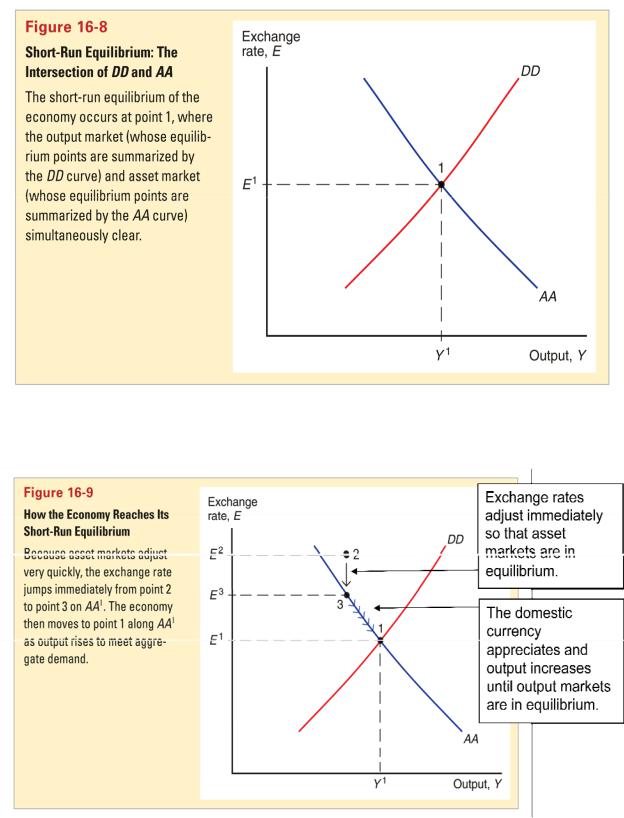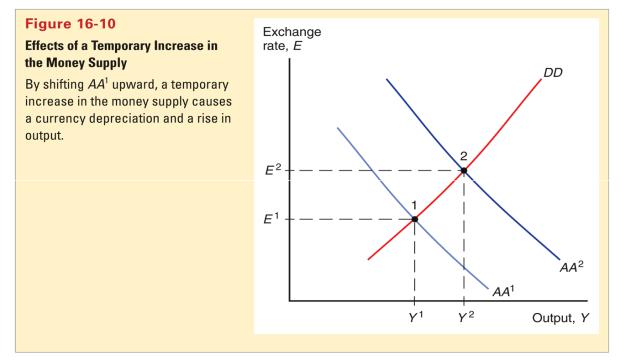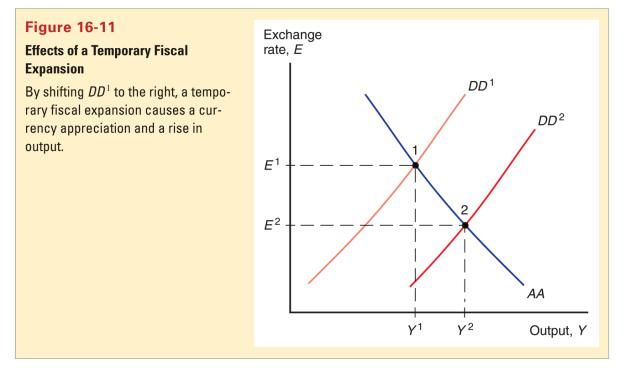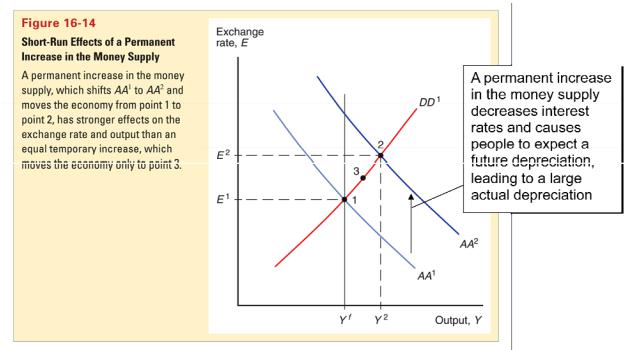
10686
.pdf2.Changes in P: An increase in the domestic price level decreases the real money supply, increasing interest rates, causing the domestic currency to appreciate (a fall in E): the AA curve shifts down (left).
3.Changes in real money demand: if domestic residents are willing to hold lower real money balances, interest rates fall, leading to a depreciation of the domestic currency (a rise in E): the AA curve shifts up (right).
4.Changes in R*: An increase in the foreign interest rates makes foreign currency deposits more attractive, leading to a depreciation of the domestic currency (a rise in E): the AA curve shifts up (right).
5.Changes in Ee: if market participants expect the domestic currency to depreciate in the future, foreign currency deposits become more attractive, causing the domestic currency to depreciate (a rise in E): the AA curve shifts up (right).
Putting the Pieces Together: the DD and AA Curves
•A short run equilibrium means the nominal exchange rate and level of output such that:
1.equilibrium in the output markets holds: aggregate demand equals aggregate output.
2.equilibrium in the foreign exchange markets holds: interest parity holds.
3.equilibrium in the money market holds: real money supply equals real money demand.
4.A short run equilibrium occurs at the intersection of the DD and AA curves
1.output market equilibrium holds on the DD curve
2.asset market equilibrium holds on the AA curve

How the Economy Reaches Equilibrium in the Short Run

Temporary Changes in Monetary and Fiscal Policy
•Monetary policy: policy in which the central bank influences the money supply.
Monetary policy primarily influences asset markets.
•Fiscal policy: policy in which governments (fiscal authorities) influence the amount of government purchases and taxes.
Fiscal policy primarily influences aggregate demand and output. Temporary policy changes are expected to be reversed in the near future and thus do not affect expectations about exchange rates in the long run.
Temporary Changes in Monetary Policy
•An increase in the level of money lowers interest rates, causing the domestic currency to depreciate (a rise in E).
The AA shifts up (right).
Domestic products are cheaper so that aggregate demand and output increase until a new short run equilibrium is achieved.

Temporary Changes in Fiscal Policy
•An increase in government purchases or a decrease in taxes increases aggregate demand and output.
The DD curve shifts right.
Higher output increases real money demand,
thereby increasing interest rates,
causing the domestic currency to appreciate (a fall in E).
Policies to Maintain Full Employment
•Resources used in the production process can either be over-employed or under-employed.
•When resources are employed at their normal (or long run) level, the economy operates at “full employment”.
When employment is below full employment, labor is underemployed: high unemployment, few hours worked, lower than normal output produced.
When employment is above full employment, labor is overemployed: low unemployment, many overtime hours, higher than normal output produced.
•Policies to maintain full employment may seem easy in theory, but are hard in practice.
1.We have assumed that prices and expectations do not change, but people may anticipate the effects of policy changes and modify their behavior.
workers may require higher wages if they expect overtime and easy employment, and producers may raise prices if they expect high wages and strong demand due to monetary and fiscal policies.
fiscal and monetary policies may therefore create price changes and inflation thereby preventing high output and employment: inflationary bias
2.Economic data are hard to measure and hard to understand.
Policy makers can not interpret data about asset markets and aggregate demand with certainty, and sometimes they make mistakes.
3.Changes in policies take time to be implemented and take time to affect the economy.
Because they are slow, policies may affect the economy after the effects of a shock have dissipated.
4.Policies are sometimes influenced by political or bureaucratic interests.
Permanent Changes in Monetary and Fiscal Policy
•Permanent policy changes modify people’s expectations about exchange rates in the long run.
Permanent Changes in Monetary Policy
•A permanent increase in the level of the money supply
lowers interest rates and it makes people expect a future depreciation of the domestic currency, increasing the expected return of foreign currency deposits.

The domestic currency depreciates more than (E rises more than) the case when expectations are constant (Chapter 14 results).
The AA curve shifts up (right) more than the case when expectations are held constant.
Effects of Permanent Changes in Monetary Policy in the Short Run
Effects of Permanent Changes in Monetary Policy in the Long Run
•With employment and hours above their normal levels, there is a tendency for wages to rise over time.
•With strong demand for output and with increasing wages, producers have an incentive to raise output prices over time.
•Both higher wages and higher output prices are reflected in a higher price level.
•What are the effects of rising prices?

Effects of Permanent Changes in Fiscal Policy
•A permanent increase in government purchases or reduction in taxes
increases aggregate demand
makes people expect a domestic currency appreciation in the short run due to increased aggregate demand, thereby reducing the expected return on foreign currency deposits, making the domestic currency appreciate.
•The first effect increases aggregate demand for domestic products, the second effect decreases aggregate demand for domestic products (by making them more expensive).
•If the change in fiscal policy is expected to be permanent, the first and second effects exactly offset each other, so that output remains at its normal or long run level.
•We say that an increase in government purchases completely crowds out net exports, due to the effect of the appreciated domestic currency.

Macroeconomic Policies and the Current Account
•To determine the effect of monetary and fiscal policies on the current account,
derive the XX curve to represent the combinations of output and exchange rates at which the current account is at its desired level.
•As income and output increase, the current account decreases, all other factors held constant.
•To keep the current account at its desired level, the domestic currency must depreciate as income and output increase: the XX curve should slope upward.

•The XX curve slopes upward but is flatter than the DD curve.
DD represents equilibrium values of aggregate demand and domestic output.
As domestic income and output increase, domestic saving increases, which means that aggregate demand (willingness to spend) by domestic residents does not rise as rapidly as income and output.
As domestic income and output increase, the currency must depreciate to entice foreigners to increase their demand for domestic output in order to keep the current account (only one component of aggregate demand) at its desired level—on the XX curve.
As domestic income and output increase, the currency must depreciate more rapidly to entice foreigners to increase their demand for domestic output in order to keep aggregate demand (by
